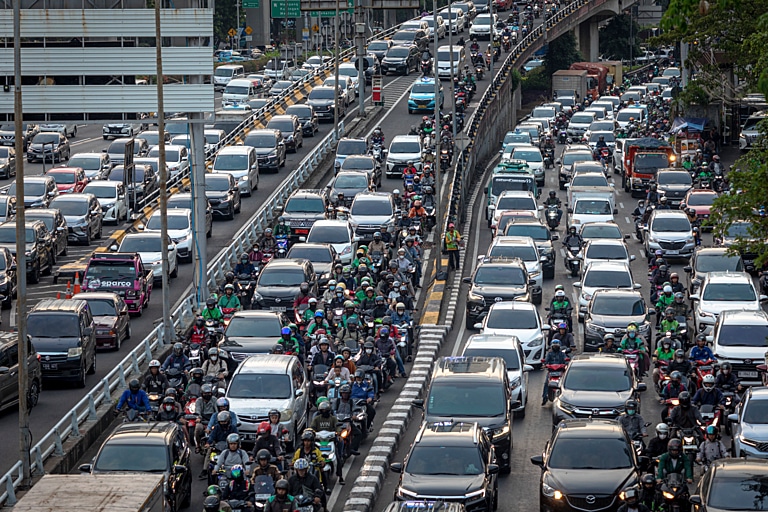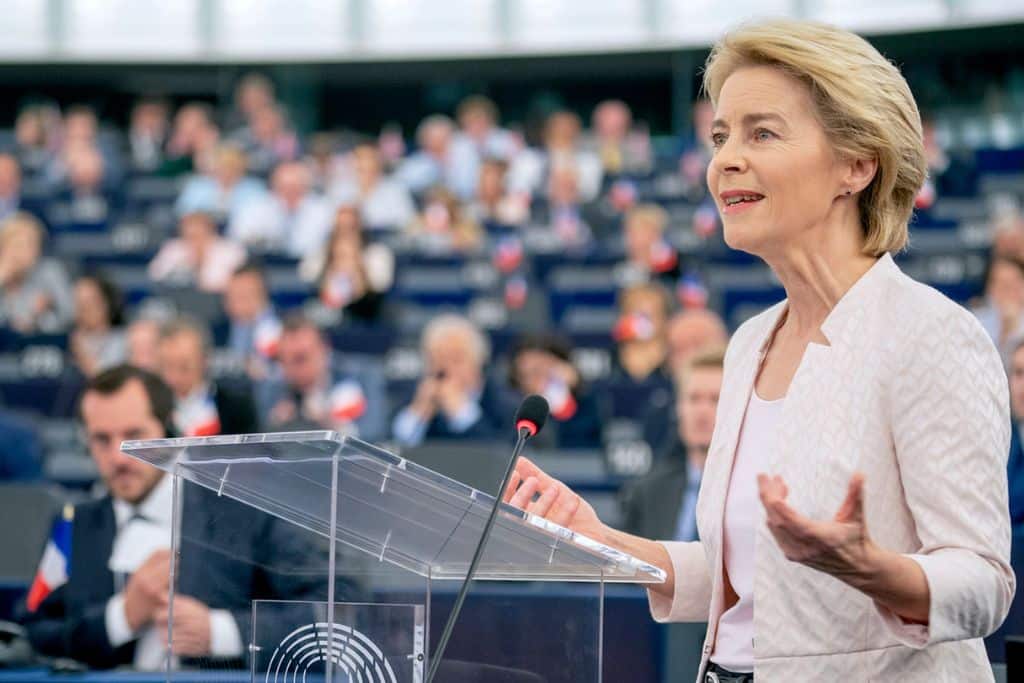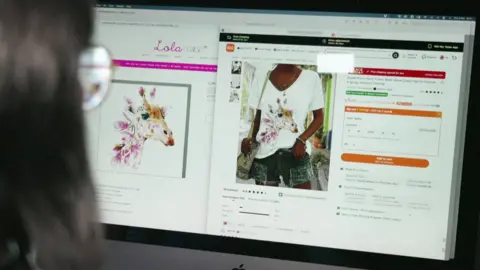Nick TriggleHealth correspondent
 Getty Images
Getty ImagesMenopause screening is to be officially incorporated into NHS health checks in England for…

Nick TriggleHealth correspondent
 Getty Images
Getty ImagesMenopause screening is to be officially incorporated into NHS health checks in England for…

A ban on the sale of new CO2-emitting cars and vans by 2035 within the European Union is currently being reviewed, reflecting the bloc’s broader strategy to redirect its focus away from the climate crisis to other pressing issues like economic security and international conflicts.
—
On September 12, the European Commission announced it would move up its review of the 2035 zero CO2 emissions target for cars and vans to the end of this year, rather than 2026.
The European Commission in 2022 announced plans to ban the sale of new CO2-emitting cars and vans by 2035 within the EU.
Several EU governments criticized the move, raising concerns about consumer choice and the feasibility of the transition. Italy, Portugal, Slovakia, Bulgaria, and Romania called for a delay to the ban. Germany also expressed criticism, advocating for a gradual transition rather than an outright ban on CO2-emitting engines. The German government reaffirmed its stance earlier this month during an automotive summit in Berlin reuniting German manufacturers, subcontractors, and representatives.
“2035 cannot be a hard deadline. That is not technically feasible,” said German Chancellor Friedrich Merz during a press conference. The government argued, in line with the position of the European Automobile Manufacturers Association (ACEA), that the 2025 emissions reduction plan should be reconsidered to protect Europe’s industrial competitiveness and the resilience of its supply chains.
The scaled up review comes in the context of weak European demand and a shift to electric vehicles (EVs). It will specifically target vans, Reuters reported. Other specifics on the new proposal remain unclear, but it may allow for the inclusion of biofuels that could continue to power internal combustion engines, plug-in hybrids or range extenders.
The Commission’s 2022 proposal received widespread criticism from European car manufacturers amid declining demand for EVs. For instance, about 8.5% of all vans sold are electric, while the figure for passenger cars is about double. In addition to weak demand in Europe, Chinese manufacturers offer electric vehicles at significantly lower prices, leaving European carmakers struggling to compete with these market leaders. More recently, US import tariffs have also made it more difficult for European carmakers to access the American market, adding another strain on the industry as a whole.
In March, the European Commission unveiled a rescue plan for the EU automotive industry, which provides 13 million jobs and contributes 7% of the bloc’s GDP. The plan includes 1.8 billion euros (US$2.1 billion) to secure raw materials for battery production within the EU and 1 billion euros by 2027 to support innovation in the automotive sector. It also seeks to stimulate demand for EVs.
Alternative measures under discussion include creating a new category for small EVs with tax advantages and extra CO2 credits to help manufacturers meet emissions reduction targets. The plan also aims to support local production of key components such as battery packs.
The potential rollback of the ban reflects a broader pattern of the EU backtracking on some of its previous climate commitments, raising doubts about whether the region still stands as a global leader in the climate and renewable energy transition.
The European Green Deal (EDG), adopted in 2020, is the cornerstone of the Commission’s sustainable policies. The deal covers several policy areas with the aim of transforming the bloc’s economy for a sustainable future. One of these goals is a 55% bloc-wide reduction in greenhouse gas emissions by 2030.
But growing resistance from right-wing groups, geopolitical tensions, and mounting pressures from industry and farmers, the future of the EU’s once-ambitious climate goals now hangs in the balance.
More on the topic: What Is the Future of the European Union’s Once Ambitious Green Agenda?
Climate-related investments in the EU have stalled after years of growth. According to a recent report by the Institute for Climate Economics, spending in the energy, transport, building, and low-carbon technology sectors stagnated in 2023, reaching 498 billion euros and declining in 2024 for the first time in several years.
The report notes that an estimated 842 billion euros are needed yearly for the EU to reach its 2030 climate targets, representing an annual shortfall of 344 billion euros. Nevertheless, in May, the Commission announced that the EU was “well on track” to reach the goal of reducing CO2 emissions by 55% that they set for themselves for 2030.
In February, the Commission presented the Omnibus Simplification Package, a set of European Commission proposals aimed at simplifying and streamlining EU rules for corporate sustainability reporting by reducing disclosures or simplifying obligations, marking a major shift in the EU’s climate policy approach. The initiative is part of a broader strategy to boost Europe’s competitiveness in an uncertain geopolitical context, driven by concerns that the European economy is stagnating. The main reasoning behind advancing the package was that too much reporting and due diligence reduced European competitiveness.
In September, the EU-Mercosur Trade Agreement, controversial for its significant environmental consequences, was approved by the European Commission. The deal aims at securing markets for European businesses and ensuring stable partnerships, especially in the automotive industry – a sign that competitiveness and trade is progressively taking precedence over environmental objectives.
Under the deal, EU-Mercosur trade in automotive components will be fully liberalized within 15 years, creating a stable political and economic partnership. Interestingly, on October 13, 26 major EU trade associations, notably the the ACEA, called for the fast, “swift ratification” of the EU-Mercosur agreement in a co-signed statement towards the EU’s institutions.The agreement is also expected to accelerate deforestation by up to 25% due to increased demand for agricultural products such as soy and sugar.
More on the topic: The EU-Mercosur Deal Comes With Serious Environmental and Social Implications
One of the most important factors explaining European scaleback is the 2024 European parliamentary election, which saw a historic surge of support for right and far-right parties, generally opposed to climate policy action.
The new right-wing majority in the European Parliament is made up of a coalition of the European People’s Party, Conservatives and Reformists of Europe, and the Patriots for Europe (former Identity and Democracy group). The coalition has repeatedly pushed for competitiveness and deregulation, criticizing the economic costs of a green transition.
For instance, in July, the far right group Patriots for Europe, currently the third largest group in the European Parliament, took control of a key climate text. Originally introduced by the Commission as a recommendation to cut greenhouse gas emissions by 90% by 2040, the proposal is now being examined and debated by the Parliament before a final vote.
Patriots of Europe lobbied actively and used their influence to secure the position of “rapporteur” for the reform of this climate law. A rapporteur in the European Parliament is a member of parliament that is appointed by a parliamentary committee responsible for handling a specific legislative proposal, to write a report containing proposals for resolutions and amendments to be voted on by the entire Parliament. The rapporteur steers their proposals through Parliament, consults with specialists, discusses the proposal with other members within the committee and “recommends the political line to be followed.”
The 2040 target is still being actively negotiated in Parliament and, substantively, the rapporteur from Patriots of Europe will not have the power to prevent other parties from reaching an agreement on the final version of the law. However, by holding this post, Europe’s far right could seek to delay or inflame the negotiations.
The European right has echoed the sentiments by certain segments of the population that view the Green Deal legislative package as elitist and disconnected from the economic consequences of the green transition. For instance, following widespread farmers’ protests in France, Italy, Spain, and Belgium last year, the Commission backtracked on several green programs, including the implementation of crop rotations or cuts to fertilizer use.
Another key factor contributing to the EU’s shifting priorities is the broader geopolitics context, which has shifted significantly since the implementation of the European Green Deal.
Russia’s invasion of Ukraine in 2022 shook the balance of Europe’s transition and exposed the vulnerabilities of the continent’s energy infrastructure. With a large share of its energy supply coming from Russian natural gas reservoirs, the war triggered a sharp rise in energy prices. The war, along with dealing with the aftermath of the Covid-19 pandemic, forced Europe to prioritize defence and security over the climate crisis.
Paradoxically, pausing climate action will likely undermine European security in the future.
For instance, 2025 saw temperature records breached multiple times across many European regions. Nearly one million hectares have burned in the EU so far this year, marking the region’s worst wildfire season on record, and scientists have warned EU lawmakers that this summer’s extreme weather events could impose at least 43 billion euros in short-term costs on the region’s economy. In 2024, record-breaking temperatures, droughts and flooding led to short term losses equivalent to 0.26% of the EU’s economic output in 2024.
As the COP30 climate summit in Brazil approaches, the EU remains divided over its climate ambitions. Last month, European environment ministers adopted a vague declaration of intent on reducing greenhouse gas emissions by 2035. In the absence of an agreement, the EU did not present a consolidated emissions reduction plan to the United Nations before the given deadline. According to French newspaper Les Échos, negotiations on the EU’s 2035 climate target stalled after several countries, including France and Germany, pushed to discuss the 2040 objective at the upcoming European leaders’ summit at the end of October, an approach that disrupted ongoing talks on the 2035 target.

European Commission President Ursula von der Leyen assured that the EU will have new climate targets by the COP30 summit. “How we reach these targets will be different. The world has changed. Global competition is fierce and not always fair. We need more flexibility, more pragmatism,” she said.
It is also important to note that the EU is still actively promoting the climate transition and some of its objectives are being reached.
For instance, the EU’s emissions trading system (EU ETS), a market mechanism that gives CO2 a price and creates incentives to reduce emissions in a cost-effective manner, has successfully reduced emissions in power generation and energy-intensive industries such as the production of iron. According to the European Parliament, between 2005 and 2023, the EU ETS helped reduce emissions from these sectors by 47%.
While setbacks and compromises persist, the EU’s fight against the adverse effects of climate change continues to evolve. Its challenge for the future will be to strategically maintain levels of progress in the climate and energy transition while mitigating continued geopolitical and economic constraints.
Featured image: Aji Styawan/Climate Visuals.
Our non-profit newsroom provides climate coverage free of charge and advertising. Your one-off or monthly donations play a crucial role in supporting our operations, expanding our reach, and maintaining our editorial independence.
About EO | Mission Statement | Impact & Reach | Write for us

Mark SavageMusic correspondent
 Jack Robinson
Jack RobinsonA couple of months ago, I found myself in a field backstage at Glastonbury standing next to Sam Ryder.
It was seven in the…

Laid out in the chief executive’s 2025 policy address (118-page // 865KB PDF), the changes will reshape compliance obligations, contractual frameworks and operational risk management across multiple sectors of the economy, with particular impact on financial institutions, logistics providers, technology companies and in-house legal teams, according to technology law expert Jennifer Wu of Pinsent Masons.
The changes when shaped could affect how contracts are formed, how shipping documents are authenticated and what counts as admissible evidence in a dispute. Businesses moving goods across borders will require systems that can generate, sign and store documents electronically in ways that satisfy both Hong Kong law and the legal requirements of other jurisdictions involved in the transaction.
Wu said: “The 2025 Policy Address signals a regulatory pivot towards digital trade, smart mobility and AI accountability. For businesses, this is both a compliance challenge and a strategic opportunity.”
“Electronic trade documentation will streamline cross-border transactions but requires robust systems for authentication, security and evidentiary integrity,” she said.
“The shift raises practical questions about digital signatures, system security, audit trails, and records retention. Exporters, freight forwarders and trade finance providers should map their current processes against likely legislative requirements, particularly where paper documentation is still standard practice, or where multiple parties in different jurisdictions must access the same documents.”
Under the planned legislation, from 2026, business-to-business trade documents in electronic formats will be legally recognised. Hong Kong SAR’s trade platform will link with systems in operation in mainland China and other ASEAN countries, while upcoming trials are replacing paper bills of lading with digital equivalents.
Legislation for drones, air taxis and other low-altitude aircraft, part of an action plan to develop transport and logistics by air, was also announced. The rules will cover safety standards, flight routes, landing sites and traffic management, while a regulatory ‘sandbox’ will let companies test these services under government supervision.
Wu said: “For logistics companies, the regulatory requirements may differ significantly from ground transport.”
“For technology providers, the sandbox offers early-mover advantage but requires detailed submissions on safety, cybersecurity and operational protocols,” she said.
“Multi-party contracts between aircraft operators, technology suppliers, insurers and customers, will need clear risk allocation, particularly where regulatory standards are still developing. Businesses should monitor draft legislation for detail on certification processes and liability rules.”
The framework will need to address operator licensing, safety certification, insurance cover, liability for accidents, and data protection where aircraft capture images or location data.
Wu said: “Contracts must address certification, liability, and data protection in an evolving legal landscape.”
“Meanwhile, AI governance expectations are increasing, particularly for financial services, where regulators will demand transparency, bias mitigation, and secure data handling,” she said.
“Organisations that act now – by auditing processes, updating governance frameworks, and engaging with regulatory consultations – will not only reduce legal risk but also gain a competitive edge in adopting these technologies.”
Three AI-related measures were announced in the policy address: a mechanism for transferring data from mainland China to Hong Kong SAR for research under secure conditions; new infrastructure including an AI supercomputing centre and a data facility cluster; and governance requirements including mandatory testing for government AI systems.
Wu said: “These measures point to increased regulatory expectations on AI security, transparency and accountability in the adoption of AI, especially in financial services.”
“Organisations using AI should review their governance arrangements – data protection compliance, model testing, bias checks and vendor oversight – against the standards likely to be applied by supervisors,” she said.
“The data transfer mechanism may enable new AI applications using cross-boundary datasets, but only under defined security controls.”
Regulatory details of AI governance are expected to be released in the next 12 to 18 months. Organisations should assess gaps in their current AI risk management frameworks or be aware of the needs in their existing organisation as the requirements continue to develop, according to Wu.

Boulton KA, Coghill D, Silove N, Pellicano E, Whitehouse AJO, Bellgrove MA, et al. A National harmonised data collection network for neurodevelopmental disorders: A transdiagnostic assessment protocol for neurodevelopment, mental health,…

Emma SaundersCulture reporter
 THOIP (a SANRIO company)/Agatha Christie Ltd
THOIP (a SANRIO company)/Agatha Christie LtdIn a first for Agatha Christie, four of the crime novelist’s famous mysteries are being adapted…

Unlock the Editor’s Digest for free
Roula Khalaf, Editor of the FT, selects her favourite stories in this weekly newsletter.
Andreessen Horowitz is aiming to raise about $10bn for new investments, as the Silicon Valley venture capital group seeks to replenish its coffers amid frenzied dealmaking for the top artificial intelligence and defence tech start-ups.
The California-based firm is seeking to raise roughly $6bn to invest in more mature companies, marking a near-doubling of its previous “growth” fund, said people familiar with the matter.
It is also targeting $1.5bn for each of its AI applications and AI infrastructure funds and more than $1bn for its “American Dynamism” defence and manufacturing-focused vehicle, two of the people said.
The combined target of $10bn would be Andreessen’s largest fundraise to date, marking a significant increase for the firm after raising $7.2bn in April last year in its latest haul. It would also be a step up from a $9bn raise during the tech boom in early 2022.
Andreessen’s rapid return to its institutional backers — known as limited partners — follows a period of prodigious industry-wide investments into AI which has led to VCs exhausting their previous funds faster than expected.
The firm has participated in a number of major start-up funding rounds since it last raised capital almost 18 months ago, including deals to back OpenAI and Elon Musk’s xAI.
Those businesses have vast capital requirements, and a large chunk of the new funding is likely to be spent on future rounds for start-ups already in Andreessen’s investment portfolio, said a person with knowledge of the matter.
Andreessen Horowitz did not respond to requests for comment.
The firm has risen to become one of the world’s top VC investors since it was founded in 2009, with $46bn of committed capital across its various funds.
Led by Marc Andreessen and Ben Horowitz, the firm has also become increasingly politically influential. The pair donated to President Donald Trump’s re-election campaign, and senior figures from the firm have left to serve in the new administration.
The firm’s former managing partner Scott Kupor now leads the US Office of Personnel Management, while its former partner Sriram Krishnan is the White House’s senior policy adviser for AI.
The firm has backed top AI and software start-ups including Databricks, and European leaders Mistral and Black Forest Labs. It also has been a backer of other highly valued tech groups such as cryptocurrency exchange Coinbase and the defence tech group Anduril.
New York, October 23, 2025 – According to the latest Global Insurance Market Index released today by Marsh, the world’s leading insurance broker and risk advisor and a business of Marsh McLennan (NYSE: MMC), global commercial insurance rates fell, on average, by 4% in the third quarter of 2025, repeating the 4% decline recorded in Q2 2025. Growing competition among insurers, coupled with favorable reinsurance pricing, were the primary drivers for the rate decline along with increased market capacity.
All global regions experienced year-over-year composite rate decreases in Q3 2025. The Pacific (at 11%), Latin America and the Caribbean (LAC) (6%), and UK (6%) regions experienced the largest composite rate decreases. Rates declined in Asia and India, Middle East, and Africa (IMEA) by 5% each; in Europe by 4%; and in Canada by 3%. The overall composite rate in the US – which remained flat in Q2 2025 – declined by 1%. Rates for property, cyber, and financial and professional insurance declined in every region.
Q3 marks the fifth consecutive global quarterly decrease following seven years of quarterly increases and is a continuation of the moderating rate trend first recorded in Q1 2021.
Other findings included:
Commenting on the report, John Donnelly, President, Global Placement, Marsh, said: “With the exception of US casualty, clients are benefiting not only from lower rates but also from opportunities to negotiate improved terms and broader coverage. These rate trends remain consistent in a market characterized by ample capacity. Barring unforeseen changes in conditions, we expect these trends to continue and look forward to helping clients to take advantage of the competitive insurance market.”

Peter RuddickBusiness reporter
 BBC/Lola Design
BBC/Lola DesignOnline shopping giant Temu has agreed to work with the greeting card industry to remove copied designs from its site more quickly.
Card firms say hundreds of their copyrighted images have been used to create cheap rip-offs, costing them thousands of pounds in lost sales.
Designers told the BBC the process for getting the plagiarised listings removed has been like the fairground game ‘whack-a-mole’ with copied products re-appearing within days.
Temu said protecting intellectual property was a “top priority” and that it was encouraging sellers to join the trial of a new takedown process specifically for the greetings card industry.
 BBC/Lola Design
BBC/Lola DesignAmanda Mountain, the co-founder of York-based Lola Design, discovered the catalogue of designs she had built up over a decade had nearly all been copied.
She found the images she had created had been lifted and were being advertised by other sellers on cards and other products like t-shirts.
Amanda bought one of the cards using her design and found the image was distorted and the paper was of a poorer quality than hers.
“It’s not a nice feeling to see something you’ve poured all your love and hours into taken within minutes,” she told the BBC. “I was in shock, and I actually thought to myself ‘what is the point of me still designing, I might as well just stop now’.”
 BBC/Citrus Bunn
BBC/Citrus BunnAmanda, and her husband and business partner Frank, estimate that fraudulent versions of their products have made online sellers £100,000 in sales, equivalent to about 13% of Lola Design’s annual turnover.
However, Amanda said it is both the emotional toll and the time taken to get the copycat products removed that have had the biggest impact.
“Every piece that I create is actually a piece of me,” she said. “I know that sounds crazy, but it is. Every designer gives out a piece of themselves because they just want to create a little bit of happiness, and it is not much to ask for people to respect that.”
 Lola Design
Lola DesignAfter pressure from the Greeting Card Association (GCA), Temu has now put in place a bespoke takedown process for the industry which, it says, will mean stolen designs are removed more quickly and won’t be able to be re-uploaded.
Previously, card firms would have to report each individual listing but, as part of the trial, they will now only have to submit one link. The software will remove the product and any others using the same design.
One card publisher, who helped develop the new system, saw 68 listings removed automatically. Something which previously might have meant 68 separate forms or emails to Temu.
According to the GCA, the system will then use AI to log the designer’s original creation as a protected image. It will then block any products using that design before they appear for sale.
 BBC/Lola Design
BBC/Lola DesignIn a statement, Temu said “intellectual property protection is a top priority” and that it had “invested heavily in resources to strengthen trust with brands, sellers and consumers”.
It said most requests to take down copyrighted content were resolved within three working days, but that greeting card firms were being encouraged to join the new trial which it said would lead to more products being removed automatically.
The system is bespoke to the card industry, however the BBC understands it could be used as a model for similar or alternative processes for other products.
Amanda Fergusson, the chief executive of the GCA, said the industry welcomed the changes. “We know our members feel very strongly about copycat sellers, and what’s more we also know customers are often disappointed by cheap copies,” she said.
“Our dialogue with Temu and the actions they’re taking, is a welcome first-step to address those issues,” she added.
For Amanda and Frank, it is not just their livelihoods at stake but the future of the whole supply chain which relies on the 1.5bn greeting cards sold in the UK each year.
“At some point, its going to be the consumers that are going to be affected, not just us as designers, because there won’t be any high streets,” Amanda said. She also had a message for people buying copycat cards: “Cheap always comes at a cost.”